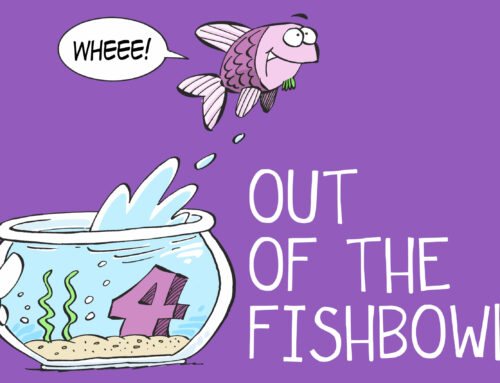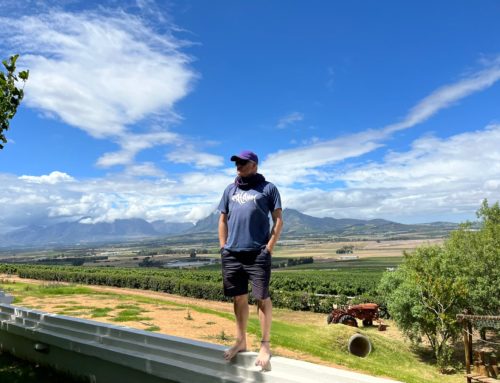i just finished reading The Art of Possibility by Benjamin Zander and Rosamund Stone Zander.
While a lot of the work in this book echoes the “Yes, Let’s!” principles of Improv that i have been playing around with for 20 plus years, i found the principles and story-telling to be quite inspiring. This is definitely a book i would recommend.
No surprise really that the short stories – and there are many of them – shared in this book of Roz and Benjamin’s experiences of seeing their principles play out are some of the highlights for me.
While some of the principles and ideas may border on cheesy for some, i honestly believe that there are some really practical principles in here worth taking on, starting with the set of questions they link to the first principle which is a reminder that almost everything in life is invented:
It’s All Invented
A simple way to practice it’s all invented is to ask your self this question:
What assumption am I making,
That I’m not aware I’m making
That gives me what I see?
And when you have an answer to that question, ask yourself this one:
What might I now invent,
That I haven’t yet invented,
That would give me other choices?
A great example of changing up your thinking like this is the nine-dot problem many of you may remember. Nine dots in a three-by-three grid and you have four lines to join all the dots, without lifting your pen. The assumption we make is that there is an imaginary boundary at the edges of the dots that we cannot cross, and yet the moment we realise that has not been specified, the solution quickly presents itself.
The moment you understand the context, suddenly the whole problem shifts, and new solutions start to appear. While looking for the image above, i stumbled upon a legit way to solve the problem using only three straight lines [which challenges the perception that the lines have to move through the middle of the dots] and so once again a whole new world of possibility opens up.
Imagine if we started all our problem-solving with this frame of mind…
You get an A and you get an A and EVERYONE GETS AN A!
One of the stories that resonated with me was when Benjamin Zander [an accomplished music conductor and teacher] tries to eliminate or work around the high level of competition in his music class.
Michaelangelo is often quoted as having said that inside every block of stone or marble dwells a beautiful statue; one need only remove the excess material to reveal the work of art within. If we were to apply this visionary concept to education, it would be pointless to compare one child to another. Instead, all the energy would be focused on chipping away at the stone, getting rid of whatever is in the way of each child’s developing skills, mastery and self-expression.
We call this practice Giving an A. It is an enlivening way of approaching people that promises to transform you as well as them. It is a shift in attitude that makes it possible for you to speak freely about your own thoughts and feelings while, at the same time, you support others to be all they dream of being. The practice of Giving an A transports your relationships from the world of measurement into the universe of possibility.
How Benjamin invited this to play out was that at the start of the year he would announce to his class that he was giving every student an A for the class. What they needed to do to earn the A was to write a letter dated a year from now looking back on the year that has passed and explaining to their teacher why they deserved their A. This revolutionised his teaching as it caused the majority of his students to reflect deeply on where they were and where they wanted to be and to start living into the A they had already received.


No More Mistakes
This is a lesson i would love to actively take from the book:
It is dangerous to have our musicians so obsessed with competition because they will find it difficult to take the necessary risks with themselves to be great performers. The art of music, since it can only be conveyed through its interpreters, depends on expressive performance for its lifeblood.
Yet it is only when we make mistakes in performance that we can really begin to notice what needs attention. In fact, I actively train my students that when they make a mistake, they are to lift their arms in the air, smile, and say, “How fascinating!” I recommend that everyone try this.

As those who follow me regularly will know, you can tell a book i have really enjoyed by how many – GASP! – corners of pages are folded over to remind me to go back and read again. The Art of Possibility has too many turned-over corners for one blog post to do it justice, but i hope you will get hold of a copy and read for yourself.
Another strong concept that stood out for me was the notion that each of us is divided into two selves. The Calculating Self basically lives from a space of scarcity and competition and needing to be on top. Maybe it could also be called The Capitalistic Self as it does describe how people in the world tend to operate in ways that don’t tend to encourage community or collective success. The idea of looking out for number one.
This is contrasted with what the Zanders call The Central Self which is a lot more positive and hopeful and tends to work towards productive and collaborative solutions.
The final concept that i want to share from the book was this idea of Rule Number 6 which i was seriously thinking might become my second tattoo just because of how powerful a reminder it could be if we lived every moment of life with this in mind:
Two prime ministers are sitting in a room discussing affairs of state. Suddenly a man bursts in, apopectic with fury, shouting and stamping and banging his fist on the desk. The resident prime minister admonishes him: “Peter,” he says, “kindly remember Rule Number 6,” whereupon Peter is instantly restored to complete calm, apologizes, and withdraws.
The politicians return to their conversation, only to be inerrupted yet again twenty minutes later by a hysterical woman gesticulating wildly, her hair flying. Again the intruder is greeted with the words: “”Marie, please remember Rule Number Six.” Complete calm descends once more, and she too withdraws with a bow and an apology.
When the scene is repeated for a third time, the visiting prime minister addresses his colleague: “My dear friend, I’ve seen many things in my life, but never anything as remarkable as this. Would you be willing to share with me the secret of Rule Number 6?” “Very simple,” replies the resident prime minister. “Rule Number 6 is ‘Don’t take yourself so g-damn seriously.'”
“Ah,” says his visitor, “that is a fine rule.” After a moment of pondering, he inquires, “And what, may I ask, are the other rules?”
“There aren’t any.”

The Art of Possibility. It might not all be for you, but i can almost guarantee that there is one story or lesson – and likely a lot more than one – that will really touch you or cause you to stop and reflect and be something you want to add to your life.
i would say the majority of The Art of Possibility deals with perception – simply looking at a problem or challenge or situation or person differently and then imagining a different outcome than the present one. i know many people who live with Art of Possibility mindsets [Val must be top of the list of those – always imagining what might be, what could things look like, how might we live or change] and they are the ones deeply involved in transformation and people development and education and justice in its various forms and spaces.
i also come across a lot of people who don’t have an Art of Possibility framework and they tend to be sad or angry people sending out angry messages on social media.
So get yourself a copy. i was given one as part of the Partners for Possibility program i am super privileged to be participating in this year and can’t wait to tell you more about that some time so watch this space.
Really enjoyed reading it and will hopefully be incorporating some of its lessons and ideas into my life and work as i reflect on them.
[For another alternative thinking that embraces the Both/And more than the Either/Or, click here]







![The Road to the Catan World Champs in Malta 2022! [Part I]](https://brettfish.co.za/wp-content/uploads/2022/11/catanchampionships-500x383.jpg)
Hello,
When it comes to possibilities, what is your opinion on Bitcoin and other coins? Do you think it is a wise investment. I know a friend who bought 500 bitcoin in 2013 and now he has around 30 million rand. He just took it and left SA. No tax, nothing. He has also moved to Italy. A life changing thing. So do you think its run its course and its no point, or do you think it has potential? This guy is set for life.
Money itself is also risky. look at the rand. Look at how it goes up and down. At least bitcoin cannot be controlled by governments.
So interesting as so many are buying it. Could you post a guide on how to do it ? Or ask one of your online panel of experts to do an article on how to buy say R1000 worth of a coin, bitcoin or dogecoin or whatever coin. Even elon musk is pushing dogecoin.
This is the opportuinity i don’t want to miss out.
Thanks
Marcus
hey Marcus, i think a lot of the movement on the bitcoin market was driven by fear or greed, neither of which i want to operate on and so despite having dabbled [bought a bit just before it went down a lot and then my account was hacked and it was taken but no huge loss] i would prefer to invest in community and people and living life well with neighbours and so community gardens and education programs [like the Partners for Possibility have embarked on] and volunteering with non-profits are so much more exciting to me [while keeping in mind that the privilege of the wealth we have coming in allows me to have more flexible hours and be involved in some of those things which not everyone has].
Thanks for stopping by.